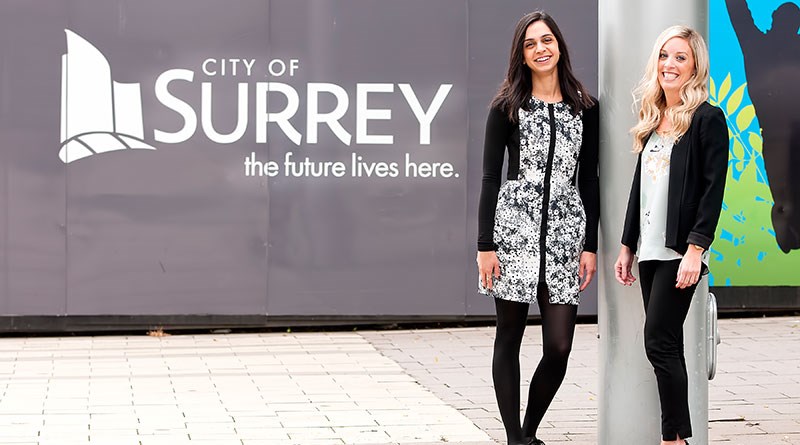Metro Vancouver’s largest concentration of millennials – those aged 19 to 34 - is in Surrey, where an estimated quarter of the region’s youth population lives, according to an Internet Trends report this year.
Carli Mauro, 30, an employment specialist, and Poonam Minhas, 27, a human resources assistant, both work for the City of Surrey, indicative of a city hall that has proved adept at attracting and retaining young talent.
The youth movement is driving everything from employment and development growth south of the Fraser River, analysts said.
Simon Fraser University’s (SFU) Surrey City Centre campus has long recognized it’s in the middle of a millennial hotbed.
Uwe Glässer, dean pro tem of SFU’s Faculty of Applied Sciences, said the idea is to engage this demographic in career paths like technology and computer science.
Glässer noted that more than a quarter of Surrey’s residents are under age 19.
The CEO of the Downtown Surrey Business Improvement Association, Elizabeth Model, has had a front row seat to the growth of the city’s core.
“My view is blocked by all these high rises going up,” she said.
Along with SFU’s campus there’s a new library, city hall and the Chuck Bailey Recreation Centre.
Work is nearing completion on 3 Civic Plaza, a tower with 353 condominium units and 144 hotel rooms, which will further expand the skyline as the city’s tallest building, right beside the SkyTrain station.
Model said it’s only natural that so much development is taking place: “Businesses want to be closer to where their employees already live,” she said.
But, as with any young, growing city, there have been setbacks. Crime is one of them. According to a 2014 Insights West poll, almost half the Surrey residents surveyed said they didn’t feel safe walking through their neighbourhood at night.
However, second-quarter statistics from the Surrey RCMP show a 4 per cent drop in Criminal Code offences. Property crimes in the area in the first half of 2016 were down more than 6 per cent compared with the same period in 2015 .
RCMP spokesman Cpl. Scotty Schumann said the city’s new crime reduction and youth units have had a positive effect, as has co-operation with other detachments to share best practices.
Housing
Young families, meanwhile are providing the impetus of a home building boom that has seen 3,635 home starts in the first eight months of this year in the Fraser Valley, 2,251 of these in Surrey.
More than two-thirds of Valley housing starts are multiple-family units, according to Canada Mortgage and Housing Corp., and real estate agents say the relatively low cost of land should keep the hammers busy.
The average prices for low-rise residential development land in most of Surrey, for instance, is from $15 to $25 per square foot, according to the LandShare 2016 report from Colliers International. This compares with $200 to $300 per buildable square foot on the West Side of Vancouver and around $125 in Burnaby.
The benchmark price of a Fraser Valley condo apartment was up 29.7 per cent to $248,800 this August compared with August 2015.
Commercial
Plans by WestStone Group and CIBT Education Group to build a $200 million, 50-storey GEC Education Mega Centre in central Surrey, is also credited to the millennial wave.
The project, yet to be approved, would be located between SFU Surrey and the future Kwantlen Polytechnical University campus.
“In a few more years Surrey will overtake Vancouver in terms of its population, the momentum is happening now and a true 21st century city is emerging,” said Brian Regehr, president and CEO of WestStone as he unveiled the proposal. Plans call for about 10 floors of student housing, 14 floors of short-stay hotel accommodation, and 20 floors of retail and office space.
Despite a 17.5 per cent office vacancy rate in Surrey, more than 165,000 square feet of office space was leased up in the city in the first half of this year, according to Avison Young. New construction this year includes the 56,000-square-foot Gateway Place and Lark Group’s mixed-used project that will include 172,000 square feet of offices.
As for retail, two Walmart Superstores opened in the region this year and, in October, the second-largest shopping centre in B.C. opens in South Delta.
Industrial land pressure
Metro Vancouver’s industrial land shortage is well known, and the eastern Fraser Valley is often seen as a place of greener pastures for development.
But there’s a shortage of industrial land there, too, according to Abbotsford city staff.
Two years ago, staff identified 1,700 acres of developable land out of a total industrial land base of 3,550 acres. Today, the best estimate of readily available, developable industrial land is less than 100 acres.
“Our staff are telling us that in between three to five years we’ll be out of serviced industrial land,” said Abbotsford Mayor Henry Braun.
Of 445 acres extracted from the Agricultural Land Reserve (ALR) in 2005 as part of Abbotsford’s City in the Country plan, 75 per cent is on track for development.
“You’re going to see buildings going up pretty quick,” Braun said.
The city’s new Official Community Plan, adopted June 27, identifies two areas for future industrial growth, comprising 690 acres of land. However, these areas remain within the ALR. •



